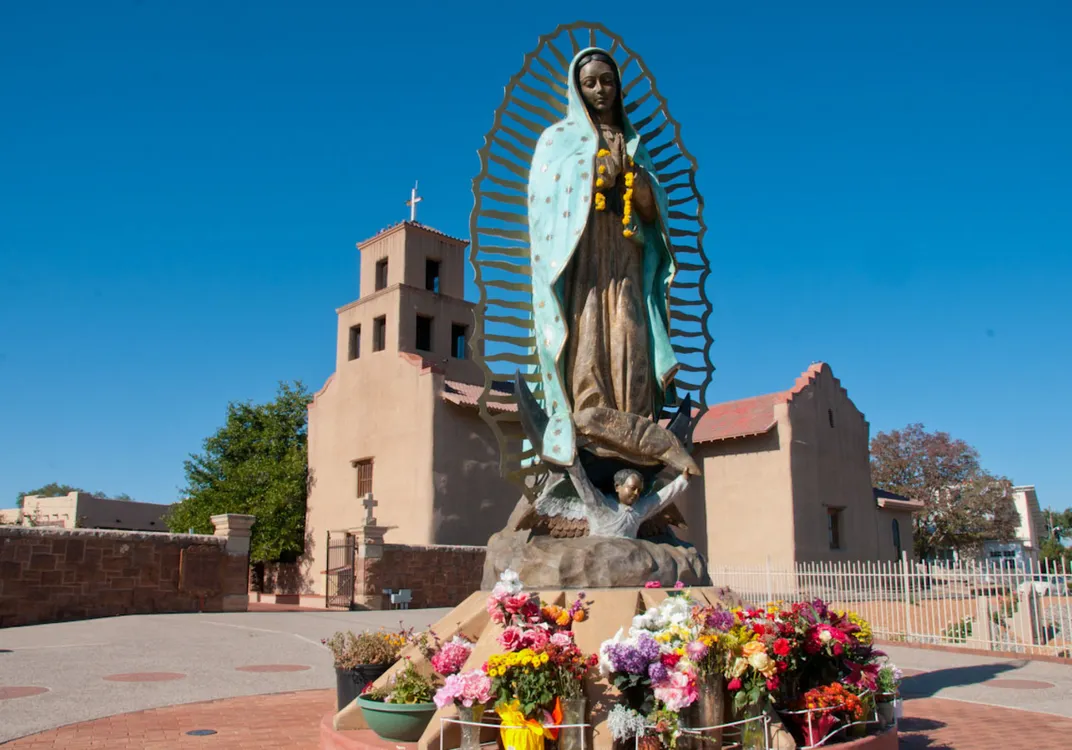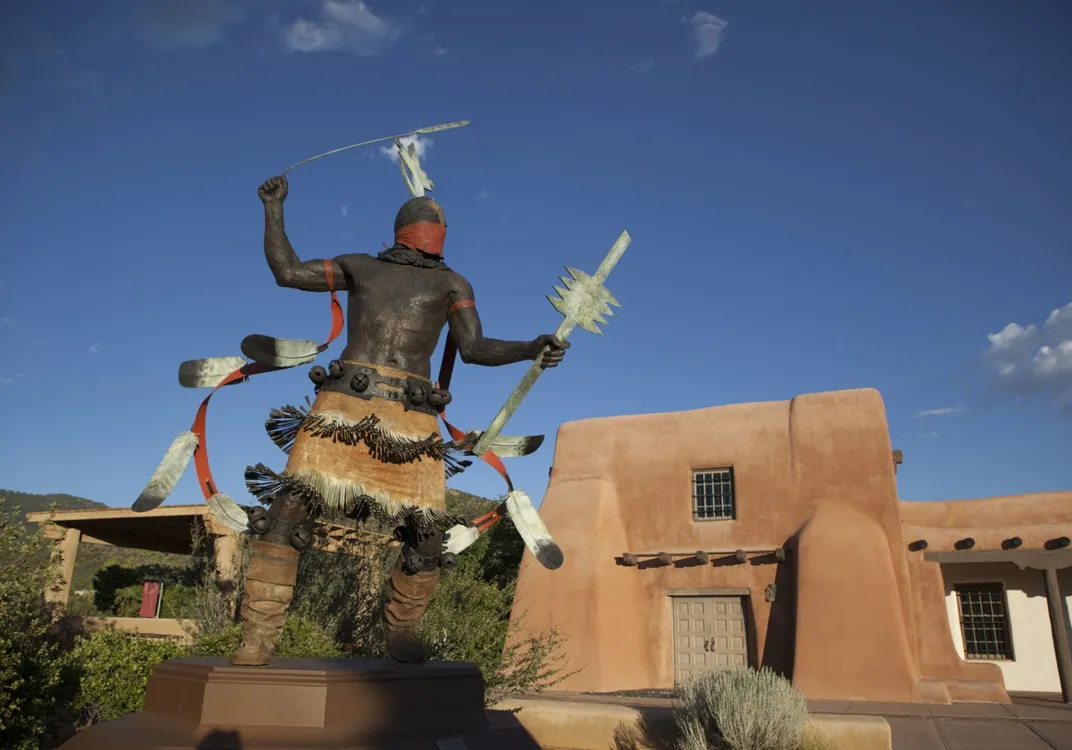When Santa Fe’s New Mexico Museum of Art Vladem Contemporary opened in fall 2023, patrons saw a familiar sight gracing its lobby: a 24-foot-long rendering of the mural Multicultural, which had decorated the side of the Railyard District’s former Halpin Building for more than 40 years. Spread across three large panels, the nearly quarter-size acrylic on canvas lobby replica is free to view, and features depictions of an Indigenous corn goddess, an Atchison, Topeka and Santa Fe Railway train, and the Rio Grande Gorge, just like the Chicano original. It’s also a testament to the history of Santa Fe and the passion of its artists—including Gilberto Guzmán, a lead painter of the 1980 Multicultural mural who also had a big hand in creating its 2.0 version.
Established in 1607, Santa Fe is not only the oldest state capital in the United States, but is also the oldest European settlement west of the Mississippi. It’s a place with a vast cultural and historic heritage that blends Spanish, Mexican, and Native American elements, and a hub of visual art showcasing these various influences. In fact, the city is home to more than 250 galleries, 20+ museums, several immersive art experiences, and dozens of art markets. But to truly experience Santa Fe’s artistic and cultural offerings, it’s best to start in the heart of the city.
Discover Historic Santa Fe
Founded by the Spanish in 1609 as a strategic defense location, Santa Fe Plaza has been downtown’s central gathering place for more than 400 years. Historic adobe structures surround this National Historic Landmark, which hosts Native American and Spanish summer markets sporting everything from Navajo pottery and woven rugs to retablos (devotional paintings) and tinwork. On the north side of the plaza stands the Palace of the Governors. Built in 1610, it’s one of the country’s oldest continuously occupied public buildings. Within its block-long covered portal, a rotating array of Native American artisans sell their handcrafted wares daily from 8:30am to 5:00pm, a tradition that dates back decades and is known as the Native American Artisan Portal Program. The majority of these vendors are members of 23 federally recognized Native American tribes, pueblos, and nations located throughout the state, and more than 1500 artisans are authorized to participate in the Portal Program.

The only Santa Fe hotel that’s situated on the plaza, La Fonda on the Plaza, is a historic Pueblo-revival style beauty that also occupies the site of the town’s first inn. From its days as a stopping point along the 1,590 mile Camino Real de Tierra Adentro, the earliest Euro-American trade route in the U.S., to its role as the terminus for the 800-mile-long Santa Fe Trail—not to mention its days as a renowned Harvey House railway hotel—this revitalized and restored property is oozing with regional history.
New Mexico’s natural beauty served as a catalyst for modernist painter Georgia O'Keeffe, whose large-format flowers, desert motifs, and abstract works are on full display at downtown’s Georgia O'Keeffe Museum Galleries, alongside hundreds of her other pastels, paintings, and sculptures. The entire collection makes up the single largest repository of O'Keeffe's work on the planet.
For a more varied look at the American Southwest, there’s the New Mexico Museum of Art. Housed in a pueblo revival structure reminiscent of New Mexico’s historic churches, this state-run facility boasts a collection of artwork that encapsulates regional heritage, from the View of Santa Fe Plaza in the 1850s, an oil on canvas painting by Gerald Cassidy, founding member of the Santa Fe Art Colony., to William Penhallow Henderson’s pastel on paper Pueblo Adobes.

Built in 1781, the Santuario de Nuestra Señora de Guadalupe offers its own form of cultural exploration. As the oldest church in the U.S. dedicated to Our Lady of Guadalupe, it doubles as an art and history museum. Don’t miss the Archdiocese of Santa Fe's collection of New Mexican santos (wood-carved images of saints). Originally constructed between 1610 and 1628 by Tlaxcalan Indians who came as slaves from Mexico, the Spanish Colonial-style San Miguel Chapel sits across the river from downtown in the city’s Barrio de Analco Historic District. It’s considered one of the oldest church buildings in the country.
Make Your Way Up to Museum Hill
Approximately 1.5 miles south of the Santa Fe Plaza sits Museum Hill, home to some of Santa Fe’s oldest streets, several of its most public sculptures, and four world-class museums. Two in particular share the story of New Mexico’s Native American and colonial history.

The Museum of Indian Arts & Culture tells the Pueblo, Navajo, Apache, and other indigenous cultures of the Southwest through typological collections of arts and artifacts, including jewelry, textiles, and nearly 300 ceramic vessels created by artists of the Pueblos of New Mexico and Arizona. From here, make your way to The Museum of Spanish Colonial Art to learn about the Spanish Colonial period of the region’s history through more than 3,000 objects that run the gamut from devotional to decorative. Taken together, these pieces convey the ongoing evolution of New Mexico’s Hispanic culture, as well as its importance in the global art landscape.
See How Santa Fe’s Past is Being Reimagined for its Future
Seven blocks southwest of the Santa Fe Plaza, the city’s burgeoning Railyard Arts District is a hub of contemporary lofts, galleries, and museum spaces that have created a new epicenter for Santa Fe’s cutting-edge art scene. Once home to a bustling railway yard and train depot, the neighborhood and its warehouse-style structures now host high-end places like the Blue Rain Gallery, brimming with a wonderful selection of regional, Native American, and studio glass art, and Zane Bennett Contemporary Art, a modern gallery specializing in editioned works on paper.

The neighborhood’s 13-acre Railyard Park features a rotating array of public art, from its “living laboratory of eco-centric artworks” such as Infinite Green, a sculptural installation created out of repurposed artificial grass and a reclaimed push mower, and Human Bird Nest, constructed right on site using locally sourced plant material.
However, it’s the New Mexico Museum of Art Vladem Contemporary that so perfectly pulls together Santa Fe’s history and future. The two-story structure is an adaptive reuse of the old Halpin Building, a brick and steel warehouse that was used as a repository for state archives, and an arm of downtown’s New Mexico Museum of Art. With an added 35,000-square-feet of exhibit space, Vladem Contemporary can house everything from large-scale installations to multimedia projects. Still, it’s the rendering of the neighborhood's Multicultural mural hanging in the museum’s lobby that perhaps best illustrates Santa Fe’s artistic and cultural ethos: to understand the present, you must delve into the past.


/https://tf-cmsv2-smithsonianmag-media.s3.amazonaws.com/filer_public/eb/b7/ebb713e5-810a-4462-a8be-2ae0b20e814a/7234c24cbb2c7b93a2b97d04643f62850154e1d720df12837c73c4cc3a0ce586.png)